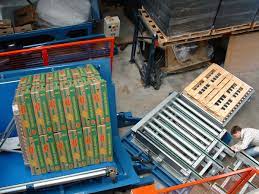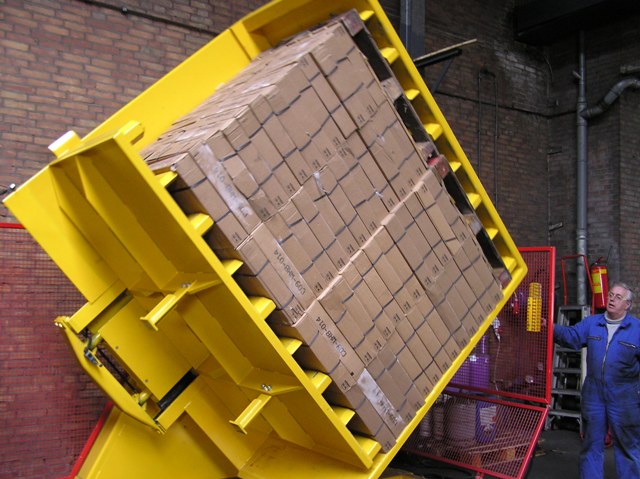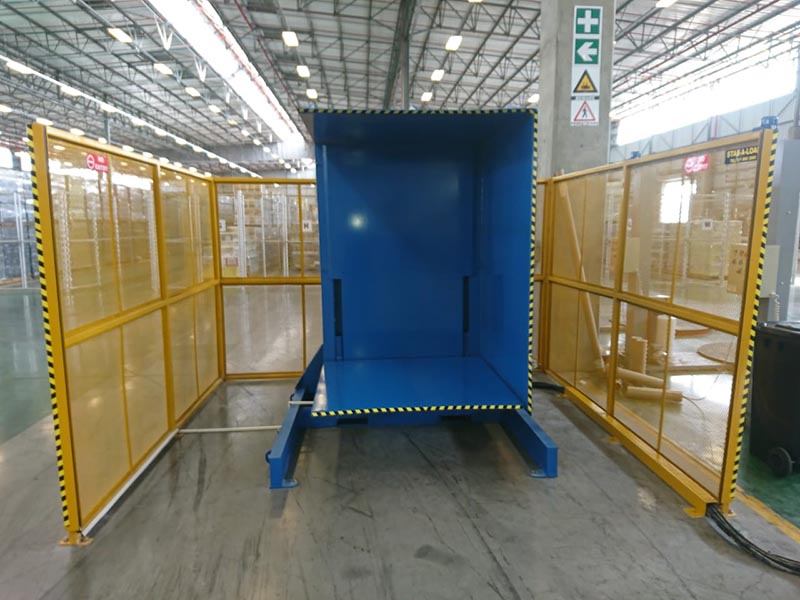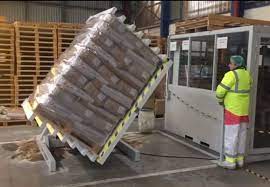Pallet Inverter: How to Rotate Heavy Cement Bag Pallets Safely?
Handling heavy pallets of cement bags presents a constant challenge. The process is slow, physically demanding, and frankly, dangerous. I've seen operations where teams struggle to manually transfer these loads, risking back injuries with every lift. I've also seen the financial impact of a single dropped pallet—product wasted, schedules delayed, and messy cleanups. This inefficiency and risk directly chip away at your profit margins. But there is a straightforward solution designed specifically for this problem: a dedicated pallet inverter that automates the entire rotation process safely and quickly.
A pallet inverter is the most effective way to rotate heavy cement bag pallets safely. It works by using powerful clamping platforms to secure the entire load from the top and bottom. The machine then smoothly rotates 180 degrees, allowing the old pallet to be removed and a new one placed on top before rotating back. This entire process is controlled by a single operator from a safe distance, eliminating manual lifting and minimizing the risk of both worker injury and product damage.

This might sound like just another piece of equipment, but as a fellow engineer and factory owner, I understand your perspective. You're not just buying a machine; you're investing in a solution that must deliver a return. You need to see how it addresses your core challenges, from aging equipment to operational costs. So, let's go deeper than the surface and analyze how this technology can be a strategic asset for a high-capacity facility like yours.
What are the biggest risks of manually rotating heavy cement bag pallets?
You see your team using forklifts and manual labor every day to switch out broken or unsuitable pallets under stacks of cement bags. It's a routine task, but it’s one filled with hidden dangers. Every time a worker has to pry, lift, or reposition a heavy load, you are one slip away from a serious incident—a torn bag, a collapsed stack, or a back injury that could affect an employee for life. These events are not just unfortunate accidents; they are costly disruptions that halt production, trigger insurance claims, and create waste. To find a better way, we must first be honest about the true costs of the old way.
The most significant risks associated with the manual rotation of heavy cement bag pallets include severe worker injuries, especially chronic back problems and acute strains; substantial product loss from dropped pallets and torn bags; and major operational bottlenecks that slow down your entire production line.

The Human Cost of Manual Handling
When we talk about risks, we often think in terms of numbers on a spreadsheet. But the human cost is the most critical. A single cement bag can weigh 40-50 kg (around 90-110 lbs). A full pallet can exceed 1.5 tons. Asking employees to manually handle this kind a weight, even with the help of a forklift, is asking for trouble.
The primary risk is musculoskeletal injuries (MSIs). These include:
- Lower Back Strain: The most common injury, caused by awkward lifting and twisting motions. This can lead to chronic pain and long-term disability.
- Shoulder and Neck Injuries: Resulting from reaching and pulling heavy loads.
- Crush Injuries: The catastrophic risk of a hand, foot, or limb being caught under a shifting or falling load.
These injuries are not just statistics. They affect real people and their families. For a business owner like yourself, they also translate into higher worker's compensation insurance premiums, lost time, and a negative impact on team morale. A safe workplace is a productive workplace. When your team sees that you are investing in their safety, they are more engaged and motivated. This is an intangible benefit that is hard to quantify but incredibly valuable.
The Financial Drain from Damaged Product
Every time a pallet of cement bags is handled manually, you risk financial loss. The paper or plastic bags are prone to tearing or puncture from forklift tines or rough handling. When a bag breaks, the product is often lost. If it gets wet, it's completely unsalvageable.
Let's look at the costs in a more structured way:
| Cost Factor | Manual Handling Method | Impact on Your Business |
|---|---|---|
| Direct Product Loss | Bags are torn by forklifts or dropped during transfer. | A single pallet of 40 bags, if lost, represents a direct loss of raw material and the revenue it would have generated. This adds up quickly over a year. |
| Cleanup Labor | Spilled cement powder requires workers to stop their primary tasks to clean up. | This is un-budgeted labor cost. It pulls skilled workers away from value-adding activities, creating a secondary bottleneck. |
| Disposal Costs | Hardened or contaminated cement must be disposed of, often as special waste. | This adds another layer of cost and environmental compliance paperwork, directly affecting your goal of reducing operational expenses. |
These small, recurring losses are like a slow leak in your revenue pipeline. A pallet inverter contains this risk by keeping the load stable and secure throughout the entire process, virtually eliminating handling-related product damage.
How does a pallet inverter improve both safety and efficiency for heavy loads?
You're facing the classic industrial challenge: how to increase output without compromising the safety of your people. Your aging equipment is likely creating bottlenecks, and any manual process, especially one involving heavy loads, is a prime candidate for failure. You can't afford the downtime or the risk. What if you could turn this vulnerable point in your production line into one of your most reliable and efficient operations? This is precisely what a pallet inverter is engineered to do.
A pallet inverter dramatically improves safety by completely removing the need for manual lifting during pallet exchange. It boosts efficiency by transforming a multi-step, multi-person task into a swift, automated cycle that a single operator can complete in less than a minute, directly increasing your plant's throughput.

A Safe Process by Design
The core value of a pallet inverter is safety through engineering. It replaces a chaotic and unpredictable manual process with a controlled, mechanical one. Think about your current method. It probably involves one forklift lifting the pallet, while workers try to manually slide a new pallet underneath. It’s unstable and requires people to be in close proximity to a suspended, heavy load.
A pallet inverter eliminates this entirely. Here’s how the design ensures safety:
- Secure Clamping: The machine’s top and bottom platforms apply consistent, even pressure to the load. This prevents shifting during rotation. The pressure is adjustable, so it holds the cement bags firmly without crushing them.
- No Manual Lifting: The operator never touches the load. They control the entire process from a console, safe from any potential crush zones or strain injuries.
- Controlled Rotation: The 180-degree rotation is smooth and stable. There are no sudden movements or jolts that could destabilize the stack of bags.
- Integrated Safety Systems: Modern pallet inverters come with standard safety features like light curtains, pressure-sensitive mats, or physical guarding. If a person enters the operational area while the machine is active, it immediately stops. This is a critical feature for meeting modern safety standards and protecting your team.
Quantifying the Efficiency Gains
For a CEO like yourself, efficiency is measured in time and money. A manual pallet exchange is a drain on both. Let's compare the processes directly.
| Metric | Manual Pallet Exchange | Pallet Inverter Process | Improvement |
|---|---|---|---|
| Labor Required | 2-3 workers + 1 forklift operator | 1 forklift operator | -66% to -75% labor |
| Time per Pallet | 5-10 minutes | < 60 seconds | >80% time reduction |
| Process Steps | Lift load, support load, remove old pallet, insert new pallet, lower load. | Load pallet, clamp, rotate 180°, exchange pallet, rotate back, unload. | Fewer, safer, automated steps |
| Throughput | 6-12 pallets per hour (max) | 40-60 pallets per hour | ~400% increase in throughput |
These are not just small improvements. This is a fundamental transformation of a key logistics process. For a plant with a capacity of 2 million tons, these gains translate directly into your goal of higher capacity utilization. By removing this bottleneck, you enable the rest of your production line to run more smoothly. This is how you start to achieve that 95% effective run time you're targeting. The pallet inverter doesn't just solve a problem; it unlocks potential.
What key features should you look for in a pallet inverter for cement bags?
You’ve decided that a pallet inverter makes sense strategically. Now comes the practical part, the engineering decision. As someone who has built and sold these machines for years, I know that not all inverters are created equal. For an application as demanding as cement bags—heavy, dusty, and abrasive—choosing a machine with the wrong specifications is a recipe for failure. It could lead to more downtime and product damage than the manual process you're trying to replace. Making the right choice means focusing on the details that matter for your specific environment.
When selecting a pallet inverter for heavy cement bags, you must prioritize three key features: a heavy-duty construction capable of handling over 2 tons, adjustable clamping pressure to secure the load without damaging the bags, and robust, sealed components that can withstand a dusty industrial environment.

Construction and Load Capacity
Your product is heavy. A standard pallet of cement can easily weigh 1,500 kg to 2,000 kg. Therefore, the first thing to look for is the machine's load capacity. Don't just meet your current maximum; choose a machine with a capacity at least 25% higher than your heaviest pallet. This provides a safety margin and accounts for any future changes in packaging or pallet size.
Look for a frame built from heavy-gauge structural steel, not bent sheet metal. All welds should be clean and continuous. The moving parts, especially the rotation mechanism and clamping hydraulics, must be oversized for the load they will handle. This robust construction is essential for long-term reliability and addresses your challenge of aging equipment. You are not buying a machine for 5 years; you are investing in a solution for the next 15-20 years. In a steel mill environment, durability is non-negotiable.
The Critical Role of Clamping Pressure
This is perhaps the most important feature for handling bagged products. Too little clamping pressure, and the stack of bags will shift or collapse during rotation. Too much pressure, and you will burst the bags, creating the very waste you're trying to prevent.
A high-quality pallet inverter for cement bags must have:
- Adjustable Pressure Control: The operator must be able to easily set and adjust the clamping pressure from the control panel. This allows you to find the perfect setting for your specific product and stacking pattern.
- Large Clamping Platforms: The surfaces that contact the load should be large and flat to distribute the pressure evenly across the entire top and bottom layers of bags. This prevents pressure points that can cause damage.
- Optional Soft-Touch Surfaces: For particularly fragile bags, you can sometimes add a layer of hard rubber or urethane to the clamping platforms to provide extra cushioning.
Controls, Automation, and Environmental Resistance
A machine is only as good as its control system and its ability to survive in its environment.
- Control System: Look for a simple, intuitive PLC-based control system. Push-button controls are often more reliable in dusty environments than touch screens. The system should allow for both manual control and a one-touch automatic cycle. This connects directly to your goal of digitalization—this machine can and should be able to communicate with your MES (Manufacturing Execution System) to track pallet movements and cycle times.
- Environmental Sealing: Cement dust is abrasive and conductive. It will destroy unsealed electronic components and bearings. Ensure that the main motors, hydraulic power pack, and electrical cabinets are sealed (e.g., IP65 rated). Bearings should be sealed and have easily accessible grease points for maintenance. This focus on preventative maintenance is key to achieving the higher uptime you need.
| Feature | Basic Requirement | Ideal for Your Operation (High-Volume, Harsh Environment) |
|---|---|---|
| Load Capacity | 2,000 kg | 2,500 kg+ for safety margin and future-proofing. |
| Clamping | Fixed pressure | Fully adjustable pressure with a gauge on the control panel. |
| Construction | Standard steel frame | Heavy-duty structural steel frame, oversized hydraulics/motors. |
| Controls | Basic buttons | PLC with automation cycle, potential for MES integration. |
| Safety | Emergency stop button | Full safety guarding with light curtains or laser scanners. |
| Environment | Standard components | IP65-rated electrical cabinets and sealed motors. |
By focusing on these specific engineering features, you move from just buying a pallet inverter to investing in a reliable, long-term solution that is perfectly matched to the demands of your cement and steel operation.
My Insight: Looking Beyond the Price Tag to True ROI
As a CEO, you are constantly asked to approve capital expenditures. Every proposal lands on your desk with a price tag, and it's your job to ensure that every dollar invested generates a return. It’s easy to look at a machine like a pallet inverter and see only the initial cost. But I want to share a perspective I've gained from my own journey, from being an engineer on the factory floor to owning my own manufacturing plant. A simple cost-benefit analysis is not enough. To make a truly strategic decision, you have to calculate the total Return on Investment (ROI), including the hidden costs you eliminate and the opportunities you create.
To accurately calculate the ROI for a pallet inverter, you must go beyond the initial purchase price. The true calculation includes the significant savings from reduced labor, the complete elimination of product waste from handling, lower insurance costs from a safer workplace, and the massive financial benefit of increased production throughput by removing a critical bottleneck.

A Story from a Client Just Like You
I remember working with a plant manager at a large building materials company. He was a lot like you—pragmatic, experienced, and under tremendous pressure to cut costs and improve safety. His operation was struggling with the exact same manual pallet-changing problem. His finance department kept pushing back on the investment, pointing to the five-figure price of the machine.
We sat down and built a different kind of business case. We didn't start with the machine's cost; we started with his costs. We calculated everything:
- The average time two workers spent on each pallet change.
- Their hourly wages and benefits.
- The value of product lost to damage each month.
- The cost of one minor back-injury claim from the previous year.
- The estimated production downtime caused by this single, inefficient process.
When we added it all up, the "cost of doing nothing" was staggering. It was far more than the price of the machine. The pallet inverter wasn't an expense; it was the solution to a much larger financial bleed. He took this analysis to his board, and the investment was approved immediately. Within nine months, the machine had completely paid for itself. That is the power of a true ROI calculation.
Calculating Your Real ROI
Let's build a simple framework for your own analysis. This is a starting point, and as a strategic partner, this is the kind of work we at SHJLPACK would do with you.
| ROI Component | Calculation Input | Estimated Annual Savings |
|---|---|---|
| 1. Labor Savings | (2 fewer workers) x (Hourly wage) x (Hours per day spent on task) x (250 work days) | $XX,XXX |
| 2. Product Savings | (Avg. pallets damaged per month) x (Value per pallet) x (12 months) | $XX,XXX |
| 3. Uptime/Throughput Gain | (Value of increased production per hour) x (Hours saved per day) x (250 work days) | $XXX,XXX |
| 4. Safety & Insurance | (Reduced insurance premium) + (Avoided cost of one potential injury claim) | $X,XXX |
| Total Annual Savings | Sum of the above | $XXX,XXX |
Simple ROI Formula: (Total Annual Savings / Initial Investment Cost) x 100% = ROI %
When you look at it this way, the investment is no longer a cost center. It's a profit driver. It directly addresses your goals of lowering operational costs by 8% and increasing capacity utilization.
This is why you seek a strategic partner, not just a supplier. A supplier sells you a machine. A partner understands your operational challenges—from energy costs to digitalization—and helps you build the business case for a solution that delivers long-term value. My journey has taught me that success comes from helping my clients succeed. This is how we build lasting relationships based on trust and shared goals.
Conclusion
A pallet inverter is not just equipment. It is a strategic investment in safety, efficiency, and long-term stability for handling heavy loads like cement pallets.



